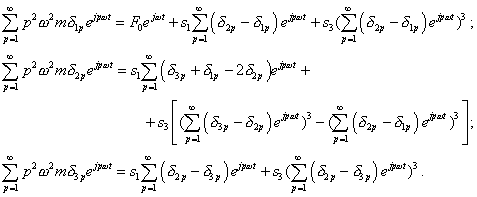| SELF | 32 |
S.B. Karavashkin and O.N. Karavashkina |
|
|
|
In other words, the form of solution
(8) differs from the form of Fourier
expansion, so that it is a functional series that is formed as a result of sequential
compensation of higher harmonics that arise in the system of equations with the
non-linearity. Proceeding from the fact that expansion of stiffness coefficient (1) contains only the growing powers of Of course, if the expansion (1) had some other form - for example, |
|
|
(12) |
then, following the chosen way, we would have to seek the solution in some other form that would allow to find the solution for an elastic system with a non-linear constraint of the type (12). However, since the expansion (12) is far beside the frames of our investigation, in the meantime we will confine ourselves to the class of non-linearities described by the expansion (1); in this way we will additionally emphasise the forms diversity of the non-linear dynamic problems and corresponding diversity of approaches to their solving. The studying of the solutions of nonlinear problems on the basis of expansion with the help of Volterra series similar to (12) can be found in the book by Wilson J. Rugh [22]. True, the condition of smallness of the model nonlinearity which we can neglect in our approach retains in that case. As a consequence of the above, the convergence of (8) will determine not the admittance of
expansion Proceeding from the above analysis, the technique to find the solution of nonlinear system of equations (3)- (4) can be determined as a sequential compensation of the residual terms of the higher harmonics when substituting the expansion (8) into this system of equations. For it, we will substitute (8) into (3) and sequentially select the terms of corresponding harmonics, basing on the fact that (3) can be identically zero only in case if the corresponding equations for all harmonics are zero. |
|
| To find the coefficients |
|
|
(13) |
As we can see, due to this substitution the modelling system (3) has gained the known form of the ensemble of equalities of harmonic components. So, as we said it above, this system identically vanishes only with the equality of related coefficients for all harmonics. To select the corresponding
harmonics, we could make use of the orthogonality of the system of functions |
|
